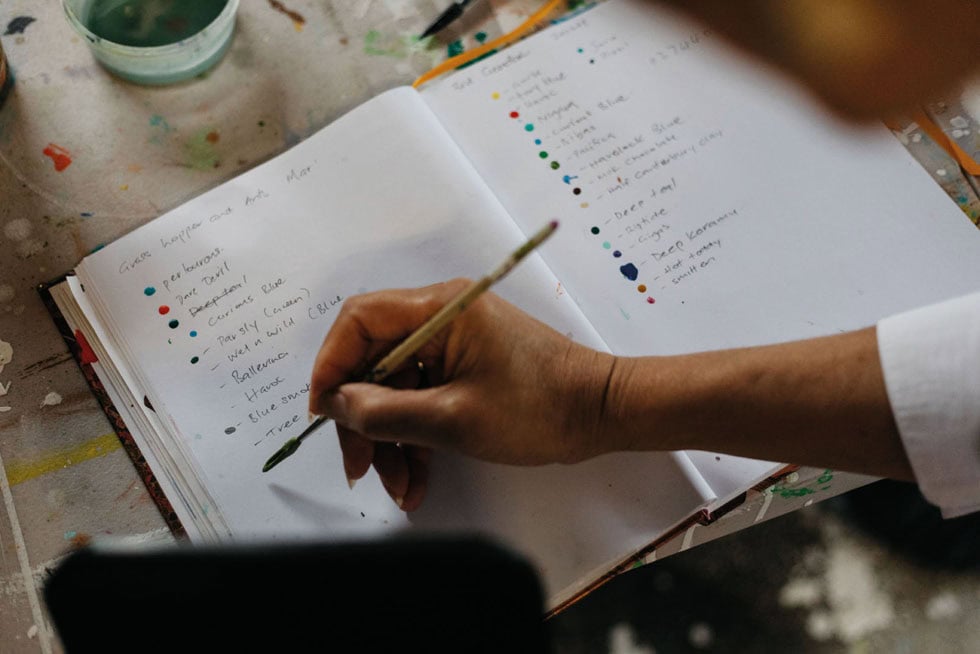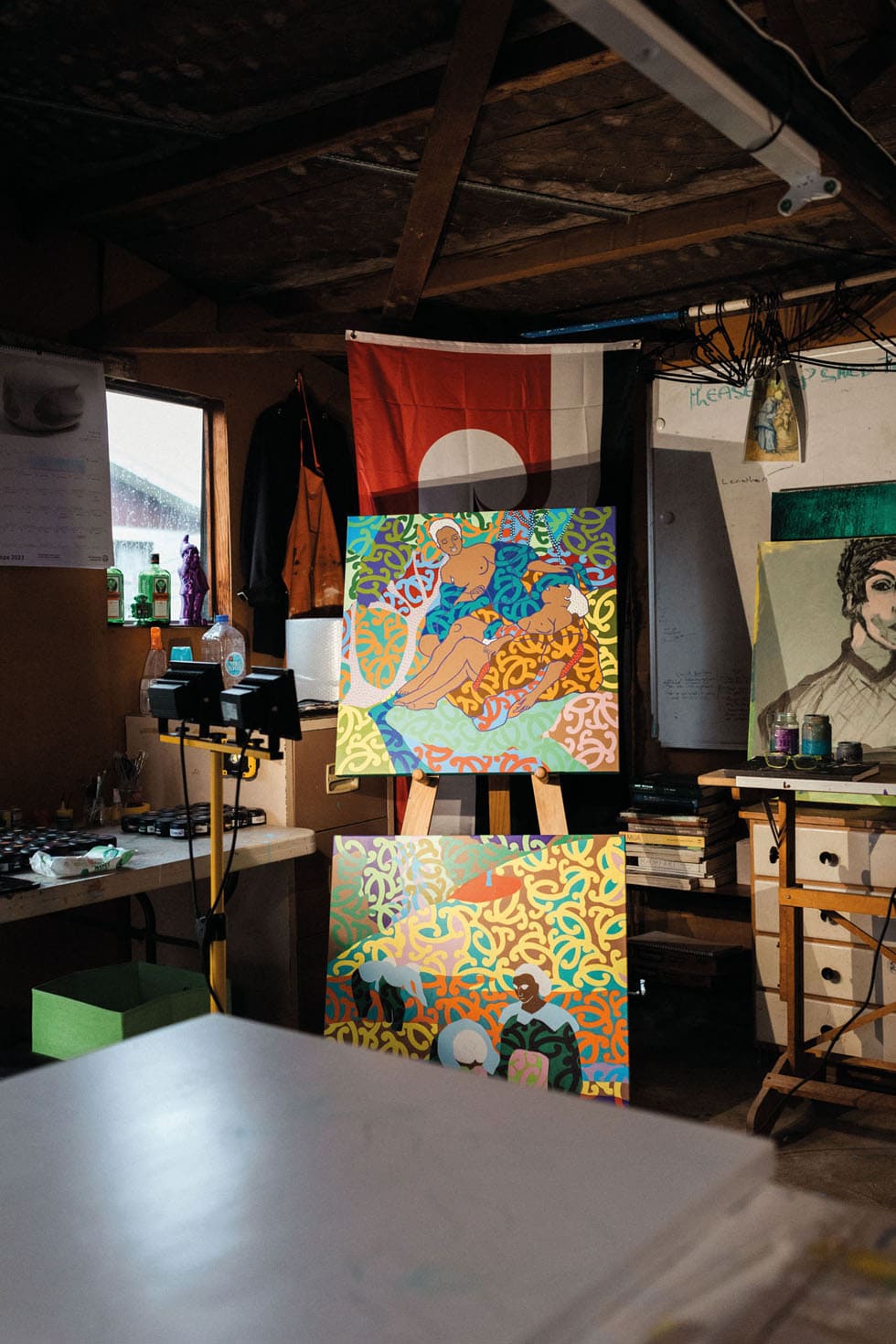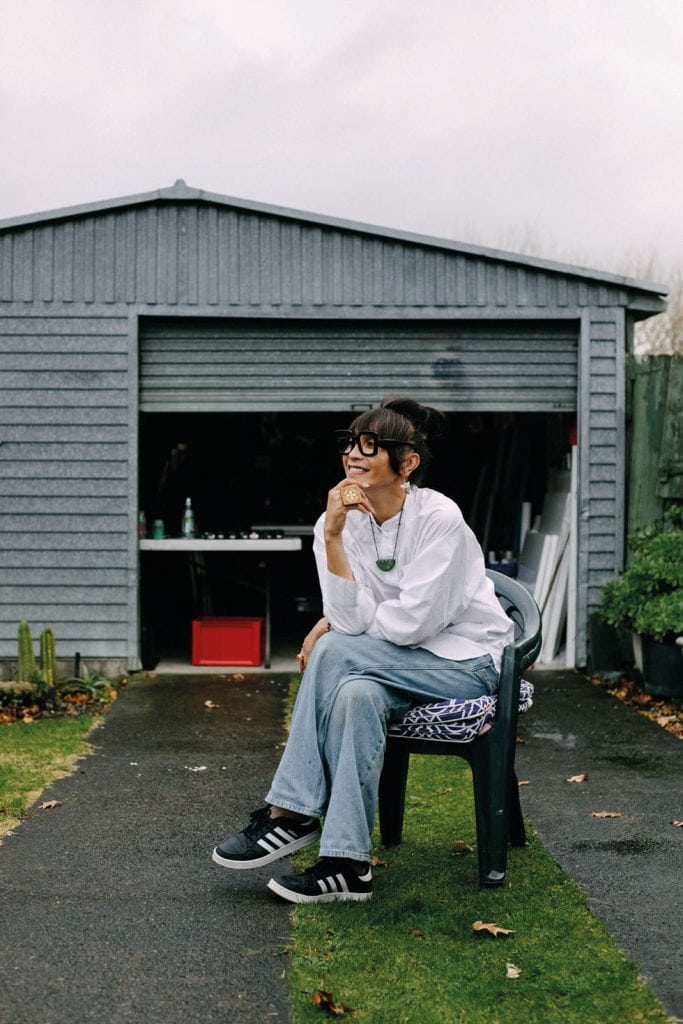Nephi Tupaea, a visionary artist with deep Māori roots, paints a new narrative of decolonisation in Aotearoa.
Tucked away on a quiet, nondescript Karanema/Havelock North street, in a kitset garage at the very end of a driveway, one of the most exciting painters to emerge in Aotearoa in recent years is hard at work.

The artist in question is Nephi Tupaea (Ngāti Koata, Ngāti Tiipa, Ngāti Koroki Kahukura, Ngāti Kahungunu) who, while having been part of the Pacific Sisters activist art collective since the ’90s, has only recently taken up painting. Despite this, she’s already shown paintings at The Dowse, Hastings Art Gallery, Tim Melville Gallery, Ākina Gallery and the National Gallery of Australia in Canberra.
Nephi, who was born transgender to Mormon parents and spent most of her adult life living overseas, returned to the house she was born in to look after her elderly mother in 2018. “It was the best decision I made,” she says.


Upon arriving home to sleepy Hawke’s Bay, she needed something creative to fill her days and soon ended up at Toimairangi, the respected Te Wānanga o Aotearoa Māori visual arts school in Heretaunga, Hastings, where she was taught by artist and art educator, Dr Sandy Adsett. It was there she developed her distinctive painting style — a contemporary mix of science-fiction-inspired technicolours, pointillist dot work and traditional koru patterns. Her paintings often replicate works by renowned artists, such as Gauguin, van Gogh and Raphael.

“I’m appropriating the European artists that infiltrated our education system. When I grew up, the only resources they gave us in the arts education system were European. There was nothing culturally significant to students such as myself. So this is my way of asking: what does decolonisation look like in art?”


Nephi describes her art practice as being ‘tīpuna-led’ — driven by her ancestors — as if they are telling her “this is your path now”. Her koru design is the mangopare, a traditional kōwhaiwhai form often associated with Ngāti Kahungunu. The shape mimics the pattern left in the sand by the hammerhead shark as it fights its way back to the water, symbolising strength and resilience. Nephi says she’s tried her hand at all the traditional koru forms but she always comes back to the mangopare. “It’s so easy to manipulate and transform into a series of other patterns. Visually, it just makes sense… it settles me and I find there’s a beautiful flow with it.” One can’t help but feel it’s another tohu, a sign of her ancestors guiding her art practice.
As we stand in the garage-cum-studio, she recounts how, when she was a child, her father would spend hours here carefully recording the whakapapa of their whānau, as far back as he could trace. In a similar vein, her paintings depict her family history.
Her version of Gauguin’s When Will You Marry? is a portrait of her great-grandmother. “Her dad was Irish,” she says, “and married a wahine Māori. She was the only and last wahine in our line who carried the moko kauae.” She goes on to say that she intentionally hasn’t rendered her great-grandmother’s traditional chin tattoo faithfully — they’re spiritual markings, so it didn’t feel right to replicate them exactly.
The spiritual realm is ever present in Nephi’s space and work. When describing her painting process, she talks about the vā, a Sāmoan concept which Albert Wendt described as “the space between, the betweenness, not empty space, not space that separates but space that relates, that holds separate entities and things together in the Unity-that-is-All, the space that is context, giving meaning to things”.
“I am continuously pulled into the vā space with Gauguin,” she says. “I give him permission to come into my space and my world, if I have permission to enter his world.”
It’s clear from the way she speaks about Gauguin that their relationship is not a negative one, despite the renowned artist often being critiqued for his fetishisation of Polynesian women. Nephi’s re-indigenisation of Gauguin’s work honours her relationship with them. “I loved his work as a 13-year-old — I loved the colours and that he was painting people who looked like me.”
Her first solo exhibition with Tim Melville Gallery, Te Tangata, explores the ongoing effects of colonisation on Māori, specifically the urban drift of working-class people leaving their kāinga (villages) in search of a
better lifestyle.
She says this took place after both world wars, and right through her childhood. The eight works in Te Tangata appropriate great post-impressionist works, transposing her own family history of working in the Pukekohe potato fields and Hawke’s Bay shearing sheds onto these well-known images of indigenous workers.
Another work, Before the Rapture, shows horses in a field. Nephi says her whānau used to own horses, but their land was confiscated after the wars. “No-one really knows what happened to our horses. Many taonga were sold to pay bills, so I’m guessing the same with the animals.”
But it wasn’t just their land and livestock lost. Her whānau also lost their language, something she and her brother are both working to reclaim. They also lost the shared pūrākau (stories) of their whakapapa. Her father worked hard to piece it together, but much of that knowledge was lost when he died and no one has picked up that legacy.
In the meantime, Nephi continues to paint the stories of her whānau, her tīpuna Māori, over the European history of art, in the space shared with all her father’s whakapapa notebooks. Guided by her ancestors in more ways than one.
Nephi Tupaea’s work is also showing as part of the Te Matau-a-Māui Contemporary Art: Gwen Malden Trust Commissions at Te Whare Toi o Heretaunga Hastings Art Gallery from July 27 until November 3 and in Paerangi: Waipawa on October 18-20, in association with Te Tuhi.
Interview Rosie Dawson-Hewes
Photography Putaanga Waitoa
Artwork photography Kallan MacLeod

